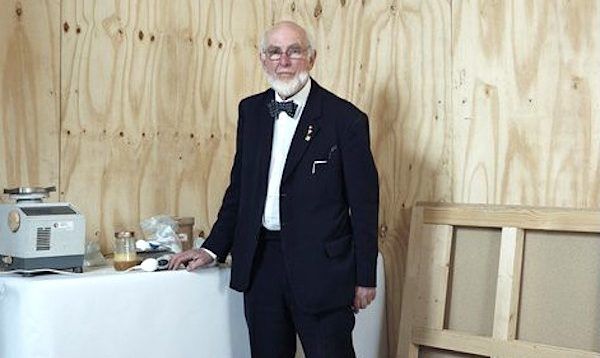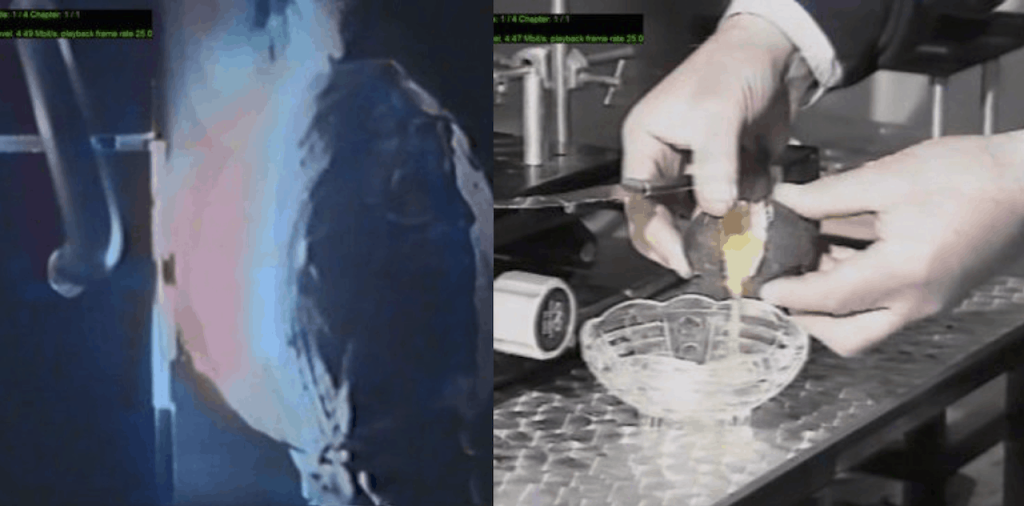Imagine the applications of a material that could resist temperatures of 10,000 degrees Celsius. That’s the temperature of the surface of the sun or the blast of a nuclear bomb. Well, one man by the name of Maurice Ward did just that in 1986. His invention of a special plastic could withstand even a nuclear flash that would otherwise melt a thick piece of steel in the laboratory. Ward’s granddaughter named the product Starlite. The problem is that his creation never came to market. As a matter of fact, he kept his formula under such tight wraps that when Maurice died in 2011, the mysteries of the Starlite material died with him.

Maurice Ward invented the mysterious heat resistant plastic, Starlite, in 1986.
Scientists have always been able to identify problems and find ingenious ways to overcome them. Maurice Ward, however, was no scientist. He was a simple hairdresser from Hartlepool in Yorkshire, England, who wanted to make the world a better, safer place. His inspiration stemmed from tragedy. In 1985, fifty-five people perished aboard a British Airtours plane within 40 seconds after the start of a fire during take off. But, it wasn’t the heat or flames that killed them. They had inhaled toxic smoke and fumes. Maurice had identified the problem. His next step was to find an answer.
From Hairdressing to Starlite
As a hairdresser, Maurice had earned local renown. He had spent many years learning to design and mix his own hair dyes, and the confident Ward would brag that his heads could never be copied. With his wife, Eileen, and four daughters, he ran a salon that was immensely popular, and customers would flock from across the north of England.
The hairdresser had never attended university, nor did he have any formal training in chemistry. The talk show host Steven Rinehart interviewed Maurice Ward around 2009, and this is what Ward had to say about how his background led to Starlite:
“I think I probably asked around a little bit, and I may have done a bit of reading, but I had to find my way around the type of materials that we needed to use, which wasn’t easy. I think it was my experience in hairdressing that really brought it together. We used to do coloring in the early days. I had about 20 years hairdressing, and it took me about three years to learn how to do coloring. It was really downstream from that as to how I came about making up the compositions and the formulations in the actual materials which we’ve used in Starlite.”
Need For a New Thermal Barrier
One thing led to another when Ward branched out into a plastics recycling business. The adroit businessman bought an extruder from Imperial Chemical Industries (ICI). This cumbersome machine was a system that would develop plastic cross-sections and took up a lot of space within his factory. Almost immediately he began to dabble with it. The more Ward tried out his new toy, the more he lost his passion for hairdressing. But he ended up with a failed extruder material that was little more than scrap. Ward binned it and forgot all about it until he saw a news report in 1985 about the British Airtours plane that suffered an engine fire costing the lives of 55 passengers.
Maurice was so shocked by this tragedy that he set out to see if he could create a substance that could withstand intense heat without emitting toxic smoke or gasses. He threw himself into his work – almost consumed by it – and eventually discovered a formula for Starlite. While Ward refused to answer any questions as to how he designed Starlite, he did reveal certain secrets about it.
The mysterious substance was based on a combination of 21 polymers and copolymers with some added ceramics. In this form, Starlite could easily withstand temperatures beyond the wildest of imaginations without giving off any toxic fumes or smoke. Additionally, its strength and durability supposedly intensified when tested. As strong as it was, being able to resist a nuclear flash and at least three times the melting point of diamonds, it was said to be flexible and able to be molded into various forms.
Tomorrow’s World Appearance
News of the Starlite material reached the producers of the BBC programme, Tomorrow’s World. In March of 1990, the show demonstrated Starlite in action. They first treated an egg with Starlite. Then an oxyacetylene blowtorch at 1200 degrees Celsius was put on the egg. The flame could not do any damage to it. Not only was the eggshell unburnt, but the yolk inside was still raw even after a constant exposure of five minutes. The presenter of the show, Peter Macann, turned off the torch. He picked up the egg with his bare hand, cracked the egg, and demonstrated to shocked viewers that Starlite was highly effective as a heat barrier. The inside of the shell was only about 35 degrees Celsius – barely warm.
Macann admitted that there were other heat resistant materials, but none that could absorb heat without giving off toxic fumes. Maurice had somehow developed a material that had endless possibilities and applications.
AWE Puts Starlite to the Test
After Starlite appeared on Tomorrow’s World, more than 3,000 inquiries flooded in. The British Atomic Weapons Establishment (AWE) at Foulness invited Ward to bring Starlite for testing. They had been trying to develop a means to withstand a nuclear flash for over 40 years. Ward was initially against the idea. He didn’t want to fail the test and, thus, diminish the results that he turned out in his own research.
However, the inventor relented and almost looked forward to the new challenges that Starlite was set. Cable covered in Starlite was subjected to light-energy sources, at a temperature of 10,000 degrees Celsius, designed to simulate an authentic nuclear flash under strict laboratory conditions. Technicians took before and after photographs, and in the end, the samples were unharmed.
In additional testing with NATO at the White Sands missile range in New Mexico, Starlite-lined eggs withstood both simulated nuclear flashes and a simulated full-scale large nuclear explosion. It appeared that Starlite was rewriting the known rules of thermodynamics.

NATO test of Starlite on egg using nuclear pulses, (L). The egg remains raw after testing, (R). Maurice Ward.
A Barrier to Lasers
An article that appeared in International Defence Review in 1993 reported that additional tests were conducted at the Royal Signals and Radar Establishment (RSRE) in Malvern. Starlite was bombarded with lasers that had the capability of burning through even the hardest of polymers. When testing was complete, Starlite showed very little signs of damage. There were tiny pits no wider than the diameter of the laser beam on the surface, but there was no indication of melting.
Professor Keith Lewis, who was in charge of this latest bout of testing, concluded that Starlite had unique properties that appeared to be totally different from other thermal barriers that were available at the time. Like most other scientists, he had no idea how Starlite actually worked. He estimated, though, that it was doing one of three things. It was either repelling the heat, absorbing it, or diffusing it. Lewis admitted that it was a complex process that could have millions of things happening at once.
Keeping the Secret a Secret
Now that Starlite had become big news, Ward’s phone was ringing off the hook. The huge number of potential investors was overwhelming. He was determined to keep his formula a closely guarded secret and even resisted patenting Starlite. Any offers to receive a sample were all met with a simple ‘no’. Only one time did Ward allow a sample out of his sight in June 1991 when he gave one to the White Sands Missile Base. However, that journey happened under the tightest of security with the assistance of the SAS. Ward would only accept joint ventures if he maintained 51% (or more) control over any projects. Also, he would not give suitors the opportunity to reverse engineer his creation by simply handing it over. Ward insisted that an agreement would need to be signed first.
According to the New Scientist, Ward negotiated with several leading organizations. Boeing, NASA, and the British Department of Defence all held talks with Ward. It seemed Ward was more concerned that he might not be able to protect himself in a litigation battle. He did maintain the utmost faith in Starlite. However, trying to broker the right deal for himself gave him the unwanted reputation as an unreliable negotiator. Supposedly, he asked for a £1 million one day but upped that price tenfold the following day.
NASA, BAE, and Boeing were unwilling to indulge Ward. Countless other organizations and contractors only ever got so far with negotiations but not one managed to secure a deal.
The End of Starlite?
Maurice Ward passed away in 2011 without ever applying for a patent. He stated that some members of his immediate family were aware of the formula, but there have never been any confirmations or denials of this. On the Steven Rinehart talk show (link below) about two years before he passed away, Ward seemed sincerely intent on releasing his mysterious plastic for the right reasons. He just never had that chance. Starlite may yet make an appearance in the corporate world in the coming years.
References:
The Telegraph
Steven Rinehart Show
New Scientist
The Verge
Tech Radar